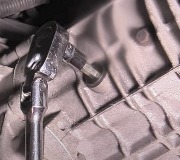You do not need a transmission specialty shop yet. Every independent repair shop will have a scanner that can access transmission computers, as well as the dozens of other computers. You might even find a scanner you can use from an auto parts store that rents or borrows tools.
Also, you can get an idea of the type of problem by when it goes to limp mode. When the problem is electrical-related, that will be detected as soon as you turn on the ignition switch, and the system will immediately start out in limp mode. Examples of electrical problems include loose or corroded connector terminals, cut or bare / grounded wires, stretched connector terminals that do not make connection with their mating terminal, corroded splices, open solenoid coil, (open means broken, as in no connection), etc. Also could be a defective pressure switch or temperature or pressure sensor. These are all things that show up right away.
Mechanical problems typically are not detected until they cause a problem, and that is usually while driving. The most common is caused by worn clutch plates. Years ago, before Chrysler invented the computer-controlled transmission, we had one to two years of warning of the impending need for a rebuild from the gradual increase in "engine runaway" during up-shifts. That was when the engine speed increased too much for a couple of seconds until the next gear finally locked up. Chrysler's computer controls did away with that. The computer learns how much fluid it takes to apply each clutch pack, and that is constantly updated after every shift. Knowing that, it will engage third gear, for example, just a little sooner, and wait a little longer to release second gear, so the overlap produces the nice crisp shift like when the car was new.
The disadvantage to this is the driver doesn't have the years of warning that wear is taking place, until the day comes when the computer can't update any further to increase the overlap. That is when excessive slippage occurs, usually during an up-shift under light throttle, and the system goes into limp mode. The fault code will have something to do with "gear ratio error" for one of the four clutch packs.
When you get a gear ratio fault code, or if you simply want to get an idea of how much life is left in the clutch packs, you can read the "clutch volume index", CVI, on the scanner. That is a set of four numbers corresponding to the volume, in CCs, of fluid it takes to apply each clutch pack. A transmission specialist can tell you the percentage of life that's left. As best as I can remember from training classes in the 1990's, "1980" or "1984" is the highest. If you see that, it is time to rebuild the transmission.
Sunday, November 27th, 2016 AT 6:43 PM


